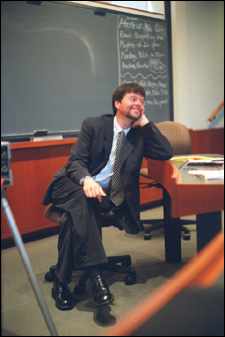Race is a refrain in Burns’ work

Ken Burns cannot tell an American story – about music, about baseball, about authors and artists, and certainly not about the Civil War – without bumping into the same issue: race.
“I found myself unable to avoid the question of race,” the celebrated documentary filmmaker said at a lecture Friday (Sept. 20) co-sponsored by the W.E.B. Du Bois Institute and the Radcliffe Institute for Advanced Study. “And in fact, I now welcome it.”
In a presentation called “Race and the Civil War Series,” Burns was joined in the Law School’s Langdell South by faculty members Susan O’Donovan, assistant professor of history and Afro-American studies; Lawrence Bobo, Norman Tishman and Charles M. Diker Professor of sociology and of Afro-American studies; and Radcliffe Institute Dean Drew Gilpin Faust for a discussion and screening of excerpts from four of his films. “The Civil War,” originally broadcast in 1990, has been digitally re-mastered and is being rebroadcast on Public Broadcasting Service (PBS) stations this week.
Just as the issue of race is “inescapable” in his films, said Burns, it is central to the American experience.
“If you’re concerned with the question of ‘Who are we?’ and ‘What does it mean to be an American?’, you are constantly brought up against the question of race,” he said in remarks as elegant and dramatic as his films.
Four clips from Burns’ documentaries illustrated his point. “The Civil War” portrayed life in America in 1861, at the dawn of the war, contrasting the peaceful daily life in Gettysburg, Vicksburg, and Richmond with the brutal existence of slaves in the South.
From “Mark Twain,” Burns told of the influence upon Twain of his cook Mary Ann Cord, an ex-slave. Hearing Cord’s slavery story – she bore seven children who were all taken from her, then she was by chance reunited with her youngest during the Civil War – impressed upon Twain the horrors of slavery as well as the power of vernacular storytelling.
A vignette from Burns’ epic 2001 series “Jazz” illustrated Louis Armstrong’s conflicted persona. Accused by some black people of turning his back on them and playing to a white audience, Armstrong took a stand in 1957, refusing to participate in a government-sponsored trip to the Soviet Union after seeing National Guard troops greeting black students with bayonets at Little Rock High School.
And “Baseball” showed Hank Aaron, who rose up from the Negro League to play for the Atlanta Braves, chasing and beating Babe Ruth’s home run record.
Scholarly perspectives
O’Donovan and Bobo lent their scholarly perspectives to race and the Civil War while lauding Burns and the series’ contribution to academia. O’Donovan put Reconstruction and the transition from slavery to freedom for African Americans in the context of other points in our nation’s history when, she said, race was not central.
“Our past is littered with differing understandings of race,” she said, telling the story of a 17th century slave who became free and lived side by side with white people. “His was a world in which race was but one marker of difference and not even the most important,” she said, citing Christianity as trumping race in social status.
For a time during Reconstruction, O’Donovan said, it seemed that America might return to the racial reality of that 17th century black man; instead, a new ideology of race emerged, characterized by segregation.
Bobo spoke about the importance of memory in shaping history, saying that we can remember the Civil War in many contexts: as a heroic moment, as a battle of brother against brother, as the end of a chivalrous era.
“It can also be thought of now as a moment of missed opportunities,” he said, “that it should have been as much in the end about racial healing as it was about sectional reconciliation; as much about becoming a whole nation not merely across the Mason-Dixon Line, but across the boundaries of black and white.”
Beyond facts and reason
O’Donovan and Bobo, as well as Faust, who served as moderator, praised Burns for harnessing the power of television to bring the subjects of academia into living rooms nationwide.
By appealing to our humanity, Burns’ films transcend what classrooms or even courtrooms can do to help erase prejudice, said Bobo.
“These visual, moving narratives engage the heart, I think, in a way that mere facts and laws never have and probably never will,” he said. “It’s very much a part, perhaps the critical part, toward fundamentally altering how each of us engage in the struggle of race and prejudice,” Bobo said.
Before a lengthy question-and-answer period, Burns echoed several of these themes. “If I had to describe what I’m interested in … it is looking for that higher emotional resonance that is in fact more precise, if I can boldly suggest that, than the reason and logic that has attended most of our inquiries,” he said.
As a society, we are “dialectically preoccupied,” grasping at distinctions and opposites – black/white, good/bad, young/old – and yearning for something to mitigate and reconcile them.
For America, Burns said, race is the key to understanding that reconciliation.




